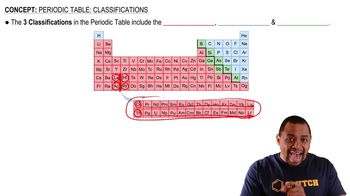Here are the essential concepts you must grasp in order to answer the question correctly.
Reduction and Oxidation
Reduction and oxidation are chemical processes involving the transfer of electrons. Reduction refers to the gain of electrons, while oxidation involves the loss of electrons. These processes are fundamental in redox reactions, where one species is reduced and another is oxidized, influencing the reactivity of elements.
Recommended video:
Oxidation and Reduction Reactions
Electronegativity
Electronegativity is a measure of an atom's ability to attract and hold onto electrons. Elements with high electronegativity, such as halogens, are more likely to be reduced, as they readily gain electrons. Conversely, elements with low electronegativity, like alkali metals, are more easily oxidized, as they tend to lose electrons.
Recommended video:
Position in the Periodic Table
The position of an element in the periodic table significantly influences its chemical behavior. Generally, nonmetals located in the upper right corner, such as fluorine and oxygen, are the most easily reduced elements, while metals in the lower left, like lithium and sodium, are the most easily oxidized. This trend is due to their respective electronegativities and ionization energies.
Recommended video:
Periodic Table Classifications




